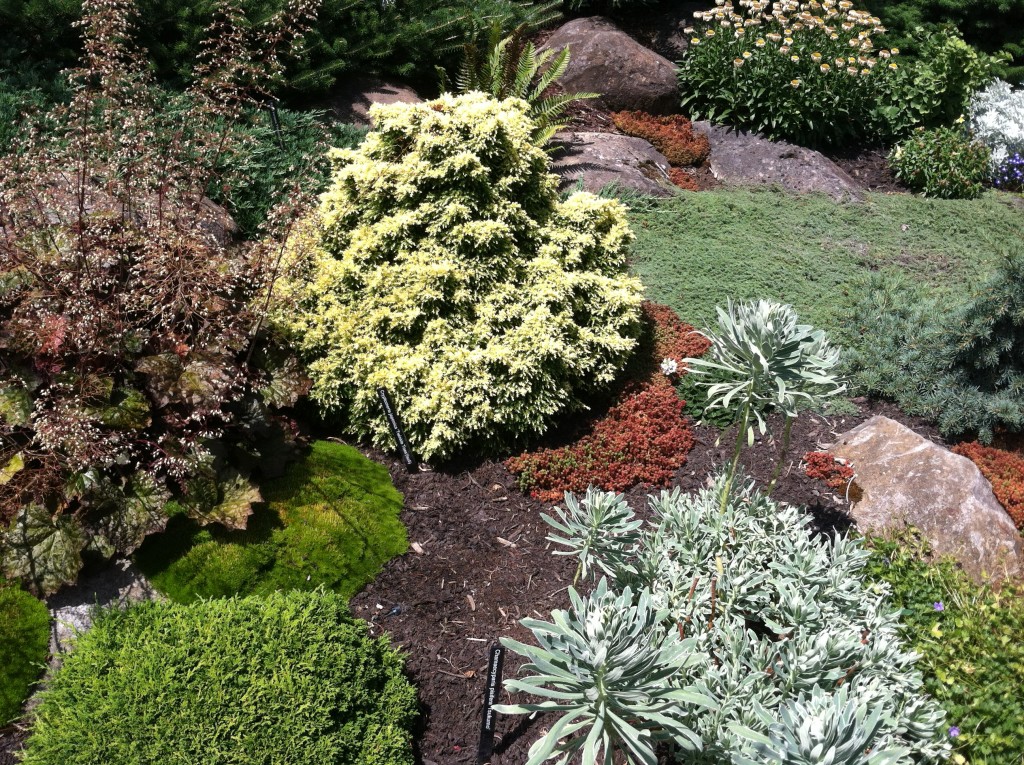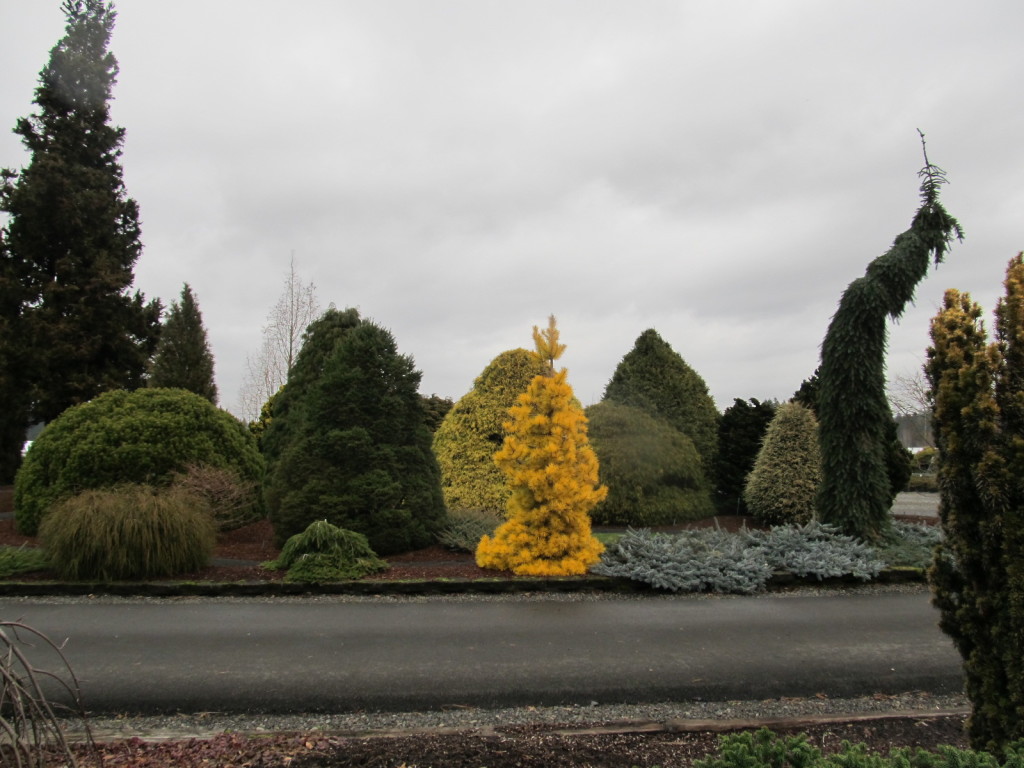(What’s a Conifer Garden with Jon Merrill)
The picture at the top of this page makes your heart hurt, right? Who knew conifers could be so beautiful and varied, and, for pete’s sake, combine to make a such a statement of a garden? My boss, that’s who. He’s the general manager for the store where I am employed, the buyer for our conifers, a past Duke University football captain, a husband, a father, a worship leader, and yes, a serious conifer lover. So, I’ll let him tell you about conifers and why you want a conifer garden, because you do, you really, really do, want a conifer garden. (One and done, anyone?)
Let’s start with the basics. What is a conifer?
Simple definition is a plant that bears cones. Like every definition, there are some exceptions to the rule, such as junipers and yews the produce berries or fruit.
So, what’s a conifer garden?
Conifer gardens are put together to show of the various colors, textures and growth patterns that these wonderful plants exhibit. Unlike other gardens, that use masses or multiples of plants, conifer gardens typically use one of each plant. Each plant is almost its own specimen when viewing, but the best way show off each plant’s individual characteristics is by having plants around it that have a different look, either in growth habit, color, or texture – sometimes all three.
Do you need tons of space for a conifer garden? And tons of money?
Conifer gardens don’t have to be very expensive. Many of the true dwarf and miniature conifers can have a relatively big price tag, but the garden does not have to be filled with them. Conifers don’t require lots of attention like a perennial garden. So, even if the initial cost of installation is a little more expensive, the yearly maintenance and time is much less. Conifer gardening can be in any size or space you choose.
Will I tend to my conifer garden differently?
Tending your conifer garden, once established, is pretty easy. Keep the weeds out (like any garden), some fertilization is always helpful, then grab a glass of wine and admire. Conifers don’t need annual pruning or cutting back. No dividing necessary. Once they get their roots out, as a general rule they are very drought tolerant.
What are the cultural requirements of a conifer garden?
Conifers need well drained, acidic soil, (5.2-5.8 ph), and the majority want lots of sun. 5-6 hours of direct sunlight. To me, they usually look best when planned and implemented on slopes or contoured garden beds.
What is your staple for a conifer garden?
This may sound funny, but every conifer garden needs a Japanese Maple or other dwarf deciduous tree. The ever changing colors on many of the dwarf forms of maples adds some needed structure and foliage contrast.
What if I live in a really hot or cold climate?
Conifers can be used in all climates. The palette of plants and placement of the garden may need to change though. For example, in very hot climates you would not use Blue Spruce or Firs but you can use Auracaria, Cypress, and even podocarpus. In some very hot areas, you may also need to have a little less afternoon sun, especially on some of the variegated, true dwarf and miniature plants. They could potentially burn in very hot locations.
Got a favorite conifer?
If I have to pick one Genus of conifer, it is Chamaecyparis. Within the different species, you can get every color, size, shape, growth habit and texture available. From giant 50-60’ trees to miniatures that might get 1 foot in 15 years. Blues, yellows, and greens, columnar and weeping, round or spreading, Chamaecyparis have it all.
We aren’t just talking foundation plants are we? I live on the corner of a four-way stop, doesn’t seem like a conifer garden space to me.
Your foundation plants don’t have to be little boxwood meatballs lining the brick. With the different heights, textures, and colors, it could be a conifer garden. A corner bed in the yard at the four way stop can be your conifer garden (it will make the neighbors jealous!). Around the back patio or deck, do you need some evergreen bones? A conifer garden! Need some new containers on front porch, yep, you guessed it, conifers! Conifers aren’t pretentious, or needy. They work in simple designs and elegant botanical gardens. From containers to large screens everyone needs to be gardening with conifers.
What about color in my conifer garden?
Chamaecyparis ‘Gimborn Beauty’ ,Thuja ‘Fire Chief’, Chamaecyparis ‘Crippsii’, Juniper ‘Grey Owl’ and ‘Blue Star’, Picea ‘Niemetz’, Picea ‘Montgomery’ , Cryptomeria ‘Golden Promise’, Picea ‘Rubra Spicata’ and ‘Acrocona’ – just look up some pictures of these plants and you will see amazing color, and not a flower in sight.
What’s their growth rate?
Check out the American Conifer Society website that gives the classifications of conifers. ACS has established four size categories- Miniature, Dwarf, Intermediate and Large – to aid in landscape design. Once established, these plants’ growth may vary some due to cultural, climatic and geographical conditions but registered cultivars have, through trials and succeeding generations, maintained their described size. The individual plant records in the ACS Conifer Database contain this information.
Landscape designers have only recently discovered dwarf conifers as housing prices climbed and lot sizes shrank. Virtually every major conifer species has a number of cultivars that defy their species by growing only a few inches a year – or less – thereby giving a small garden a palette of evergreen colors, textures and shapes that will hold together for many years, decades even.
Can any grow in shade?
As far as shade goes, many of the Taxus and Cephalotaxus, as well as, microbiota need some shade. Some true miniature and dwarf Chamaecyparis and Pines with variegation or yellow foliage need some afternoon shade or the foliage can burn. Depending on the look that you need in a certain shady location, you can use some of the Chamaecyparis or Arborvitae as long as you consider that the plant, over time, will loosen up in growth habit and not be as dense as it would in more sun.
What about the bloom?
You can grow anything you want in your conifer garden. Ornamental grasses are an excellent contrast to conifers. Flowering groundcovers are amazing to mix in. The series of plants called Toe Ticklers, a wonderful mixture of evergreen and deciduous groundcovers are a perfect combination. Many of the oriental themed gardens that you see always have mixtures of conifers and flowering shrubs.
Best Time to Plant?
In our area, conifers can be planted year round, as long as the ground in not frozen. I usually suggest spring planting with any very specialty plants, just so they have a chance to get somewhat established before winter. Fertilization – in general, conifers need less nutrient levels than broadleaf plants but I recommend using a good well balanced, organic fertilizer that contains all the micronutrient that plants need as well. It’s not just N-P-K. I have fertilizers that I would recommend but I will avoid any brand names.
Any issues we need to know about?
It varies depending on the type of plants. There are some needle and twig blights that can cause dieback on some spruce, juniper and Leyland cypress. The main insects to scout for are spider mites and bagworms.
Do you design conifer gardens?
I am not a master at conifer garden design, but I do work with customers daily when they are looking for the “Jappalachian” garden. I love the term because we can mix in many of our native with conifers for a wonderful garden.
Thank you Jon! (For a great how-to on container gardening from our store’s guru of containers, click here. )












